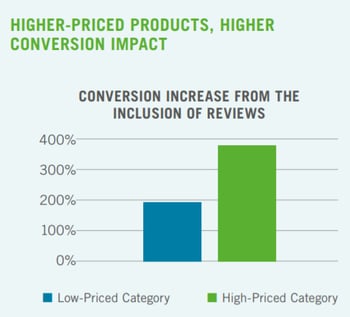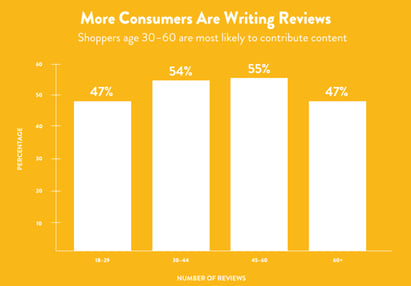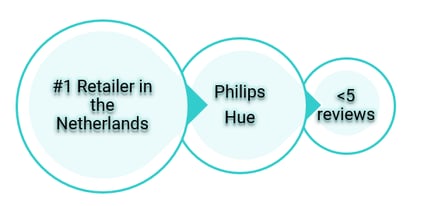We see that customers are increasingly seeking out the opinions of other consumers by reading product reviews. According to PowerReviews, 86% of all customers consider reviews as an essential resource when making purchase decisions. But how can you continuously monitor all your products on all your online retail channels? Or how to pinpoint your products with 0 or negative reviews and zoom in on specific products (SKU’s) to read the review texts?
Why Reviews are Important
eCommerce search engine results
When you get more product reviews, chances are that your products will appear higher in the Search Engine Results Page of an eCommerce platform or webshop. Product content completeness is important. More sales in combination with rich product content lead to more positive product reviews. The richer the product detail page and related content, the better conversion will be, and the better products will score in search results. Positive customer reviews have a positive effect on conversion and thus on search results. For instance, qualitative and quantitative reviews have a huge effect on winning the buy box on Amazon.
Word-of-Mouth
According to a Wunderman Thompson, report, 9 out of 10 online shoppers value the completeness of product descriptions, images, videos AND reviews. 4 out of 5 online shoppers specifically stress the importance of product reviews by other shoppers. People rely much more on the experiences of fellow consumers than the words of sellers.
Improve your product and service
You get the chance to make your products even better and show perfect customer service to your customers. Whether you receive positive or negative reviews for your products, you should get the most out of it. Reserve some time each week for reading, sharing and responding to customer reviews. Customers will appreciate it very much and you will certainly notice the benefits!
After customers place reviews it is good to place a simple thank you. It seems like a small gesture, but customers feel heard. But new customers also see that you show commitment, which makes you even more reliable as a seller. Promise improvement and come up with an allowance for dissatisfied customers and negative reviews.
Does Product Type Matter?
There are several factors that might cause a consumer to spend more energy making a purchase decision, and because of that, rely more heavily on reviews. Let’s have a look at 3 of these factors!
Price
Price is one of the primary factors that determine how “risky” a purchase is. When the price of a product is higher, there is more risk involved in the consumer’s decision and the customer takes more time and effort before buying the higher-priced product. Having more information via reviews helps to reduce that risk. In the graphic below we can see that, for a gift retailer, the conversion rate for the Low-Prices category increased 190% when reviews were displayed, and for the High-prices category 380%.

Source: Spiegel research center
Safety
How much the product affects health and safety is another important factor that influences the importance of reviews during the buying decision process. For example, a shopper will likely read more reviews when purchasing a new car seat for her child, compared to purchasing toilet paper.
New products
Reviews are widely considered to be a major driver for the diffusion of new products and services.
Online retailers, product manufacturers, and brands may need to pay more attention to early-stage reviews and to find a way to promote favorable reviews at that stage. In the early stage of a product, consumers pay more attention to online reviews. After this stage, the impact of online reviews on sales begins to decline.
Who writes Reviews?
A growing number of consumers are willing to write reviews. According to PowerReviews, in 2018, 50% of consumers write reviews for products they’ve purchased, up from 42% in 2014.
45-59-year-old
Consumers age 45-59 are the most likely to contribute content, with 55% indicating they write reviews for the products they purchase. Following closely behind are the 54% of consumers age 30-44 who admit to writing reviews. In comparison, consumers age 18-29 and those over 60 are the least likely to contribute this content, with 47% of each group indicating they write reviews.

Source: The power of reviews 2018
How to Generate Reviews?
Nowadays it is easier and cheaper than ever to collect customer feedback. This has led to an increase in survey and review requests which often leads to "Survey fatigue". Customers especially like to give feedback when it takes them one minor action that doesn’t cost much of their time.
Keep in mind when sending surveys to customers, respondents more often use mobile phones, so be careful with the number of (open) questions. Also, try to put all questions on one page with the send button in sight.
55% of consumers who don’t write reviews say they need the motivation to do so, which brings us to the next question; How to motivate customers to write reviews?
Ask for reviews
The cheapest and most effective way to generate reviews is to send an email, asking consumers to write reviews for recently purchased products. If you want customers to leave meaningful feedback, you must learn how to ask for reviews.
Promotion with vouchers
The number of customers who are sensitive to voucher promotions is large, which increases the chance of more reviews.
Example: Ask customers for a review on recently purchased items and offer a 15€ coupon. Send a clear and simple Call to Action and be transparent about the terms and conditions of the campaign.
Send samples
You can best send samples of your products when launching a new product or when you sell seasonal products that must be sold as quickly as possible. You can also send samples to a targeted product group that has a low quantity of reviews, low review ratings, or both. SiteLucent can help you target a specific set of products.
Quantity or Quality?
According to a BrightLocal survey, consumers read an average of 10 reviews (70% read 4 or more reviews, with 20% looking at more than 11). While consumers may expect a high number of reviews before feeling able to trust a business or product, it’s unlikely many consumers have the time to read hundreds of peers’ experiences before making a decision.
Besides quantity, customers care about the recency of your reviews and your overall star rating.

According to PowerReviews partnered with Northwestern University’s Spiegel Digital and Database Research Center, purchase probability peaks when a product’s average star rating is between 4.2 and 4.5 because a perfect 5-star rating is perceived by consumers as too good to be true.
A Customer Success Story – Signify Benelux
After running a quick search on the Dutch #1 eCommerce platform, 1668 product results show up in the category “smart lighting”. Of these products, 295 are Philips (HUE) branded. Even though the manufacturer of Philips Hue products (Signify), is the world leader in lighting, it still must take and maintain its position among all the other brands! But how? Reviews seem to be (one of) the answer(s)!
Find out how Signify ran a successful review campaign, powered by SiteLucent’s tooling and learn how reviews can help your company grow!
As we can read in this blog, many recent pieces of research confirm the powerful effect of customer ratings & reviews on traffic, sales and conversion in e-commerce. But how can you make review and rating data fully transparent for you as a trade marketer, member of an eCommerce team or other commercial role within a multi-channel environment? And not less important, how to monitor this customer feedback continuously and act on it in a customer-centric way?
In this Customer Success Story, we will tell you how SiteLucent tools helped Signify (Benelux area), gaining reviews for a targeted group of Philips Hue products, on their customer's online platform.
Monitoring Multi-Channel ratings and reviews
The best case is to continuously monitor all your products reviews on all your online retail channels. SiteLucent can for example help you to pinpoint your products with 0 or negative reviews on all channels and zoom in on specific products (SKU’s) to run a campaign or to read the review texts.
Targeted Review Campaigns
Review campaigns for a targeted set of products with for example less than 10 reviews, an average review rating below 4, or a combination of both, are more effective than a random campaign. We also saw earlier in this blog that targeting new product introductions or seasonal products are favorable when setting up a voucher or sample campaign to gain reviews.
Signify & SiteLucent Tooling
Signify is using SiteLucent’s tooling to monitor ratings and reviews, product content, availability, pricing and find-ability of their products on their online retail channels.
In July 2019, one of Signify’s goals was to increase the number of reviews of Philips HUE products on the #1 eCommerce platform in the Netherlands. Signify wanted to focus on products that had <5 reviews.
Upload a Product Portfolio
The first step was to get an overview of all products found on the retailer’s website. For this, we first uploaded the complete product portfolio of the targeted retailer; a CSV file which includes a product code, brand name, product name and a max of 20 optional product tags such as product category, series, status or other tags to identify products.
Filter & Zoom
Deploying these product tags made jumping to the next step easy; to zoom in to the product category ‘Philips HUE’. From here we could use SiteLucent’s handy dashboards and widgets, to analyze products with <5 reviews and set up a targeted review campaign!

Yuri Ponjee, Key Account Manager at Signify: “The SiteLucent tooling is extremely efficient and effective in identifying portfolio with low numbers of reviews or even low review scores”
Read the full case study here
Product Content Completeness
We saw earlier that the quality and quantity of reviews matter. Not only reviews but, the total Product Content Completeness is important. The richer the product detail page and related content, the better conversion will be, and the better products will score in search results.
To measure the quality of product content on retailer websites, SiteLucent makes it possible to assign a Digital Content Completeness score (DCC score) to each product. The number of reviews and the rating score are criteria that get a certain weight in the total score.
Are you ready to get started with review monitoring?
